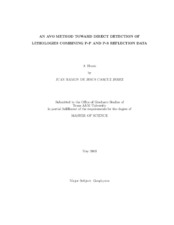| dc.description.abstract | I here present a combined AVO analysis of P-P and P-S reflection data whose objective is to improve the identification of lithology by estimating the specific values of Poisson's ratio, [sigma], for each rock formation in a given geological model, rather than a contrast between formations. Limited knowledge on the elastic parameters of a given rock formation and difficulty regarding the availability and processing of P-S data constitute hindrances of lithology identification. Considering that ocean bottom seismology (OBS) has aided in solving the problem of P-S data availability, limited information on elastic parameters is still a challenge, and the focus of this thesis.
The present analysis is based on Zoeppritz' solution for the P-P and P-S reflection coefficients, RPP and RPS, with a slight modification. We used the normalized P-S reflection coefficient; i.e.,
R'PS = RPS / sin [theta] for [theta] > 0,
instead of RPS, where [theta] is the incident angle. By normalizing RPS, we avoid dealing with the absence of converted S-waves at small incident angles and enhance the similar linear behavior of the P-P and normalized P-S reflection coefficients at small angles of incidence.
We have used the linearity of RPP and R'PS at angles smaller than 35 degrees to simultaneously estimate the average VP/VS ratio, the contrasts of P- and S-wave velocities, and the contrast of density. Using this information, we solve for Poisson's ratio of each formation, which may enable lithology discrimination. The feasibility of this analysis was demonstrated using nonlinear synthetic data (i.e., finite-difference data). The results in estimating Poisson's ratio yielded less than 5 percent error.
We generalize this new combined P-P and P-S AVO analysis for dipping interfaces. Similarly to the nondipping interface case, our derivations show that the amplitude variation with offset (AVO) of P-P and P-S for a dipping interface can be cast into intercepts and gradients. However, these intercepts and gradients depend on the angle of the dipping interface. Therefore, we further generalize our analysis by including a migration step that allows us to find the dipping angle.
Because seismic data is not available in terms of RPP and R'PS, this process includes recovery of reflection coefficients after migrating the data and correcting for geometrical spreading, as done by Ikelle et al. (1986 and 1988). The combination of all of these steps, namely geometrical-spreading correction, migration, and AVO analysis, is another novelty of this thesis, which leads to finding the specific values of Poisson's ratio of each rock formation directly from the seismic data. | en |


